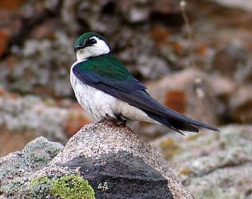|

Small swallow, dark,
metallic green upperparts, iridescent purple rump. Face, sides of rump,
underparts are white.
Tail is slightly forked.
Black bill, legs and feet. Swift, graceful flight, alternates several
quick wing beats with long glides.
Soars on thermals and updrafts.
|
VIOLET-GREEN
SWALLOW
Tachycineta thalassina
PASSERIFORMES
Swallows (Hirundinidae)
Range
and Habitat
Violet-green Swallow: Breeds from Alaska east to South Dakota, south
to southern California and Texas. Spends winters mainly south of the
U.S.-Mexico border, but a few winter in southern California. Preferred
habitats include forests, wooded foothills, mountains, and suburban
areas.
SOUND:
"dee-chip", "tweet"
The Violet-green
Swallow was first described in 1827
by William Swainson, a British naturalist.
A pair was observed assisting a pair of Western Bluebirds
in raising young. The swallows guarded the nest and tended
the bluebird nestlings, and after they fledged,
used the nest site for their own young.

A group of swallows
has many collective nouns, including a "gulp", "herd",
"kettle", "richness", and "sord" of swallows.
The Violet-green Swallow has a large range,
estimated globally at 6,100,000 kilometers. Native to the Americas,
this bird prefers subtropical or tropical shrubland, grassland, or forest
ecosystems as well as hot deserts and intertidal marine areas such as
mud and salt flats.
|